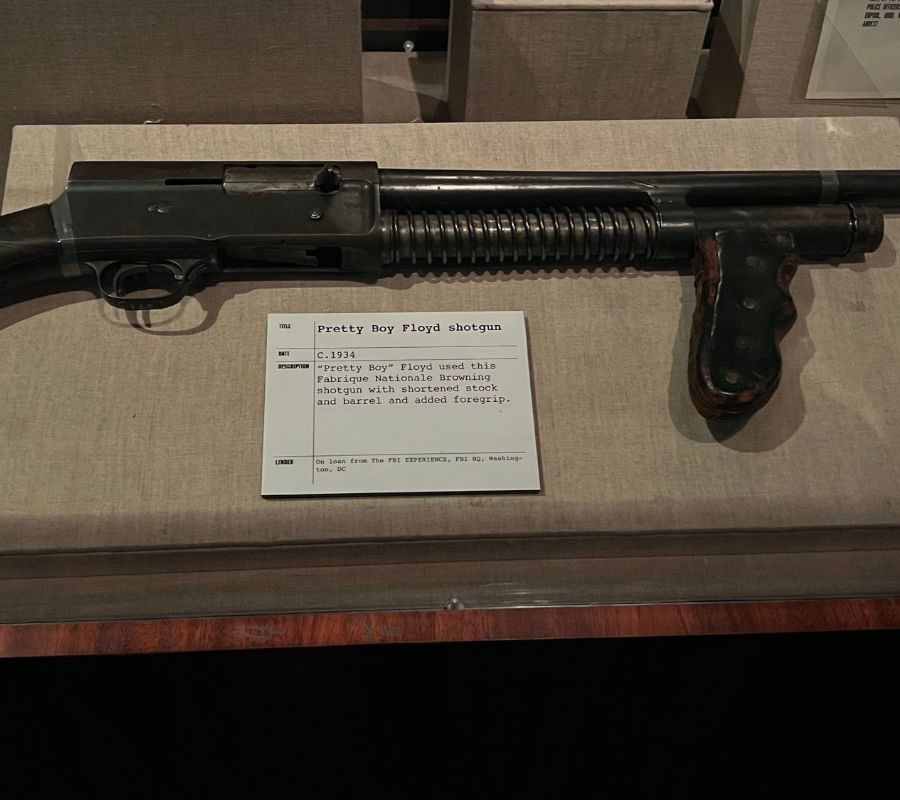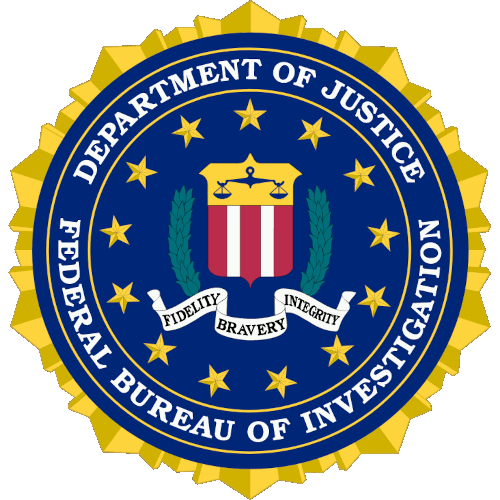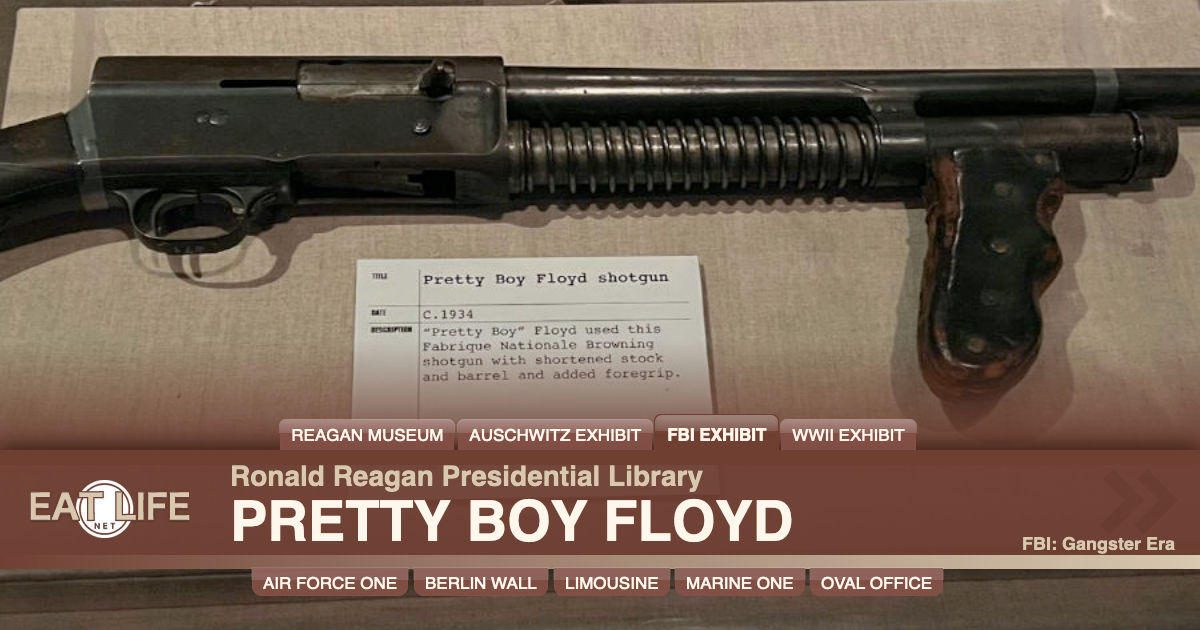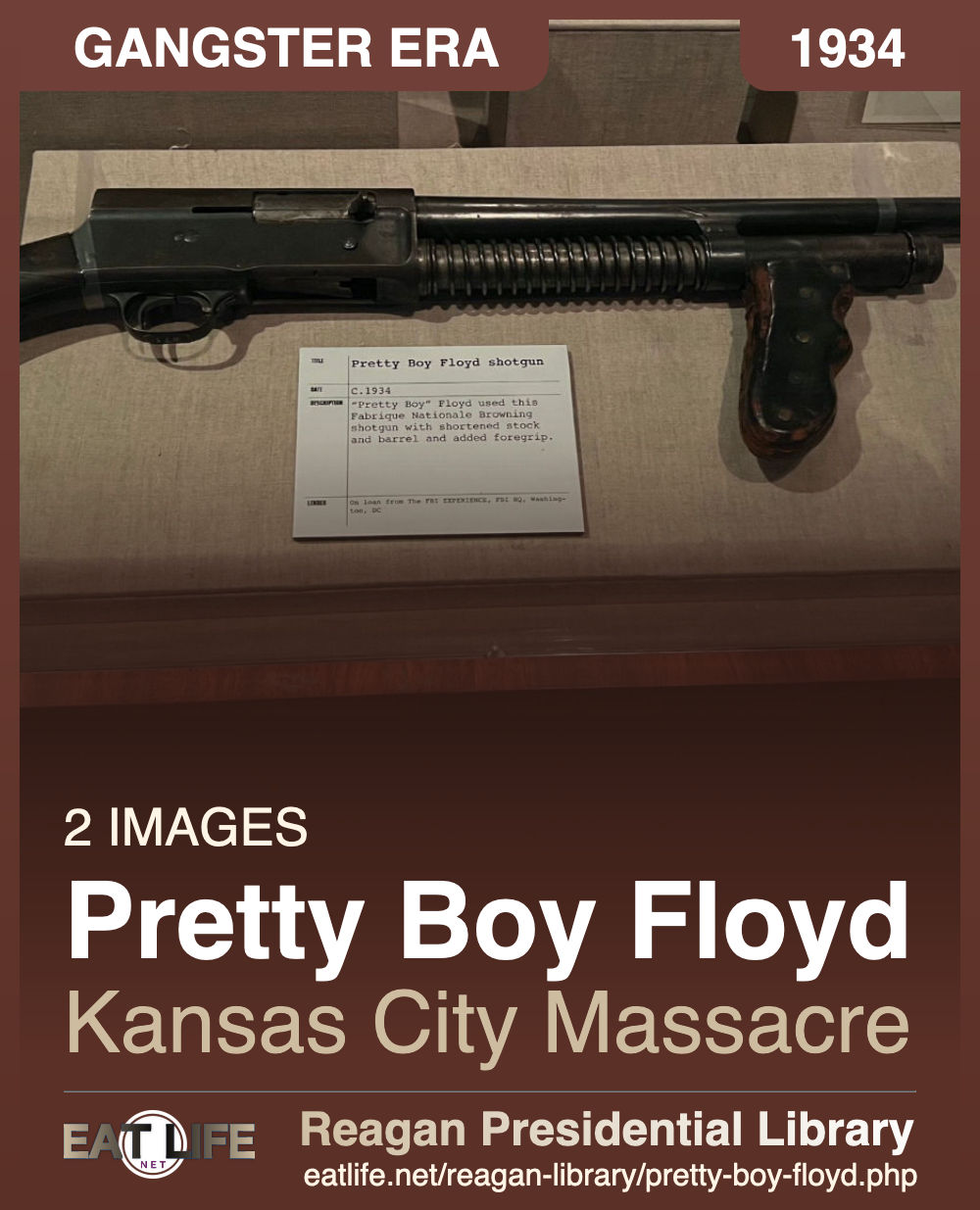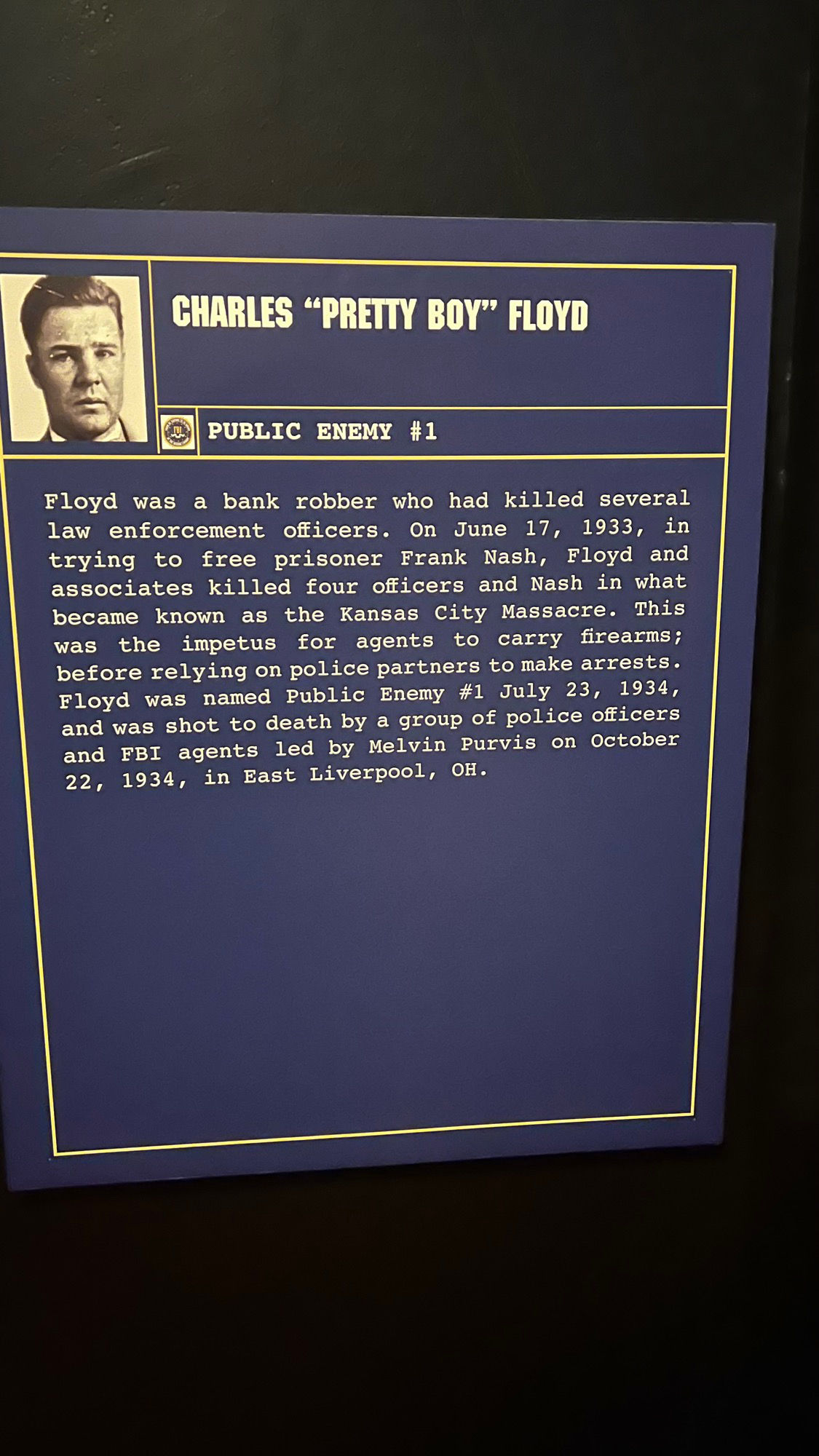
Public Enemy #1
Floyd was a bank robber who had killed several law enforcement officers. On June 17, 1933, trying to free prisoner Frank Nash, Floyd and associates killed four officers and Nash in what became known as the Kansas City Massacre. This was the impetus for agents to carry firearms; before relying on police partners to make arrests. Floyd was named Public Enemy #1 July 23, 1934, and was shot to death by a group of police officers and FBI agents led by Melvin Purvis on October 22, 1934, in East Liverpool, OH.
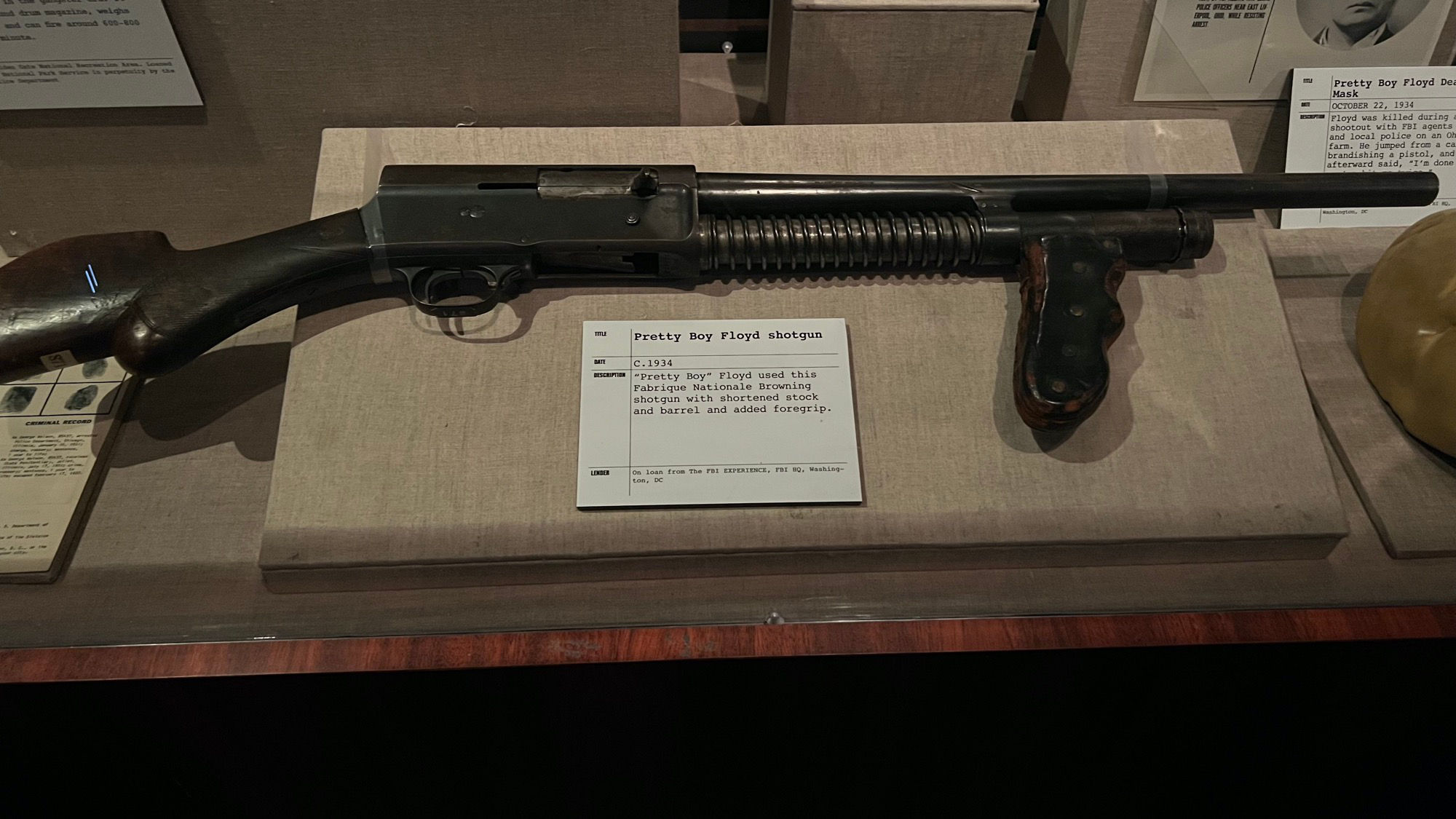
1934
Pretty Boy Floyd used this Fabrique Nationale Browning shotgun with shortened stock and barrel and added foregrip.
FBI Pretty Boy Floyd
"Choc," "Pretty Boy," "Robin Hood" - all these nicknames belonged to Charles Arthur Floyd, a bank robber who became a nationally known fugitive before his 30th birthday.Throughout the 1920s, Floyd built a reputation as a violent gangster. He stole money, robbed banks, and reportedly killed more than a half-dozen people.
On June 17, 1933, Floyd and gunmen Vernon Miller and Adam Richetti drove to a train station in Kansas City, Missouri, to try to free a federal prisoner. As federal and local officers transferred the prisoner to their vehicle, the three gunmen drew their weapons. They shot and killed four law enforcement officers, including an FBI agent.
The FBI immediately started searching for the gunmen. On October 20, 1934, Floyd, Richetti, and their girlfriends were driving through Ohio when Floyd crashed their car into a telephone pole. Floyd and Richetti hid in the woods while their girlfriends took the car for repairs.
A local police chief found Floyd and Richetti, and gunfire erupted. The police chief arrested Richetti, but Floyd fled.
Two days later, FBI agents and local officers searching for Floyd noticed a car move from behind a corn crib on a farm. Floyd jumped from the car with a .45-caliber automatic pistol in his right hand, and the officers fired.
As the officers ran toward Floyd, he said, "I'm done for; you've hit me twice." He died about 15 minutes later.
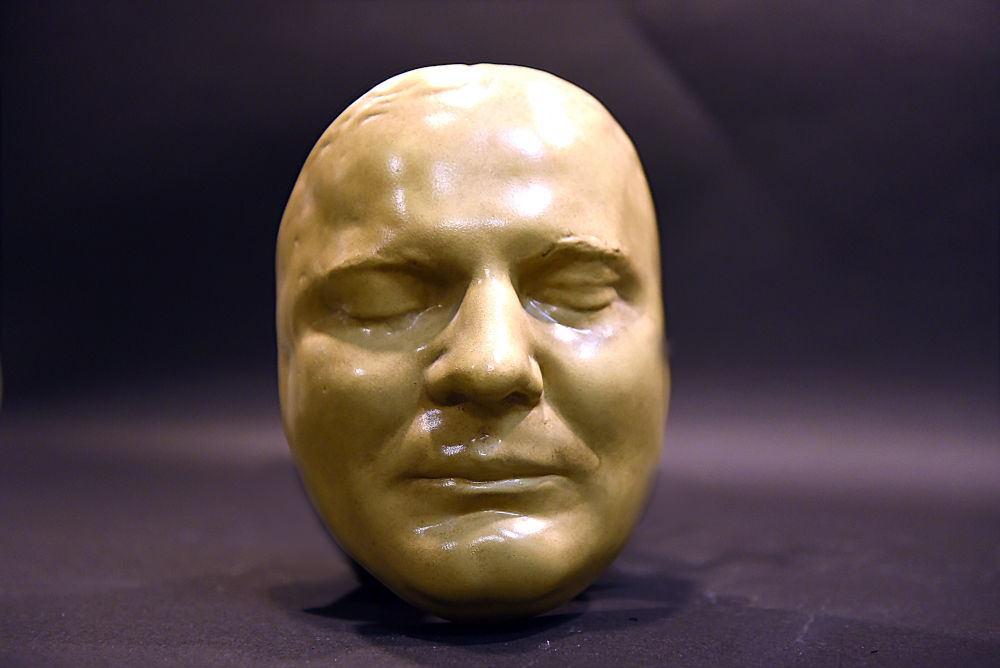 Pretty Boy Floyd's Death Mask
Pretty Boy Floyd's Death Mask
This mask of Pretty Boy Floyd’s face was made after his death on October 22, 1934.
FBI Kansas City Massacre
The sun rose on June 17, 1933 just like any other spring day in America's heartland. But outside a massive train station in Kansas City, Missouri, a grand tragedy was about to unfold.That morning, a mass murder committed in front of Union Railway Station shocked the American public into a new consciousness of the serious crime problems in the nation.
The killings that took the lives of four peace officers and their prisoner are now known as the "Kansas City Massacre."
The Criminal Motive
The Kansas City Massacre involved the attempt by Charles Arthur "Pretty Boy" Floyd, Vernon Miller, and Adam Richetti to free their friend, Frank Nash, a federal prisoner. At the time, Nash was in the custody of several law enforcement officers who were returning him to the U.S. Penitentiary at Leavenworth, Kansas, from which he had escaped on October 19, 1930.Nash's criminal record reached back to 1913, when he was sentenced to life at the State Penitentiary, McAlester, Oklahoma for murder. He was later pardoned. In 1920, he was given a 25-year sentence at the same penitentiary for burglary with explosives and later pardoned. On March 3, 1924, Nash began a 25-year sentence at the U.S. Penitentiary at Leavenworth for assaulting a mail custodian. He escaped on October 19, 1930.
The FBI launched an intensive search for Nash which extended over the entire U.S. and parts of Canada. Evidence gathered by the FBI indicated that Nash had assisted in the escape of seven prisoners from the U.S. Penitentiary at Leavenworth on December 11, 1931.
The investigation also disclosed Nash's close association with Francis L. Keating, Thomas Holden, and several other well-known gunmen who had participated in a number of bank robberies throughout the Midwest. Keating and Holden were apprehended by FBI agents on July 7, 1932 in Kansas City, Missouri. Information gained by the FBI as a result of the apprehension of these two indicated that Nash was receiving protection from his underworld contacts in Hot Springs, Arkansas.
Based on such information, two FBI agents, Frank Smith and F. Joseph Lackey, and McAlester, Oklahoma Police Chief Otto Reed located and apprehended Nash on June 16, 1933 in a store in Hot Springs, Arkansas.
The law officers drove Nash to Fort Smith, Arkansas, where at 8:30 that night, they boarded a Missouri Pacific train bound for Kansas City, Missouri. It was due to arrive there at 7:15 a.m. on June 17. Before leaving, the lawmen made arrangements for Reed E. Vetterli, special agent in charge of the FBI's Kansas City Office to meet them at the train station.
The Plan Is Set in Motion
Meanwhile, a number of outlaw friends of Nash had heard of his capture in Hot Springs. They learned the time of the scheduled arrival of Nash and his captors in Kansas City and made plans to free him.The scheme was conceived and engineered by Richard Tallman Galatas, Herbert Farmer, "Doc" Louis Stacci, and Frank B. Mulloy. Vernon Miller was designated to free Nash, and while at Mulloy's tavern in Kansas City, he made a number of phone calls for assistance in the scheme. At about this time, two gunmen, "Pretty Boy" Floyd and Adam Richetti, arrived in Kansas City, and they agreed to aid in the mission.
On their way to Kansas City, Floyd and Richetti had been detained at Bolivar, Missouri early on the morning of the 16th, when the car in which they were riding became disabled. While the two were waiting in a local garage for the necessary repairs to the car, Sheriff Jack Killingsworth entered the building. Richetti, who immediately recognized the sheriff, seized a machine gun and held the sheriff and the garage attendants against the wall. Floyd drew two .45 caliber automatic pistols and ordered all parties to remain motionless. Floyd and Richetti then transferred their arsenal into another automobile and ordered the sheriff to enter that vehicle.
The two, along with their prisoner, then drove to Deepwater, Missouri, abandoned that automobile, and commandeered another. After releasing the sheriff, they arrived in Kansas City about 10:00 p.m. on June 16. There Floyd and Richetti abandoned that automobile and stole another car to which they transferred their baggage and firearms. Finally, that same night, they met Miller and went with him to his home. There Miller told them of his plan to free Frank Nash.
June 17, 1933
Early the next morning, Miller, Floyd, and Richetti drove to the Union Railway Station in a Chevrolet sedan. There they took up their positions to await the arrival of Nash and his captors.Upon the arrival of the train in Kansas City, Agent Lackey went to the loading platform, leaving Smith, Reed, and Nash in a stateroom of the train. On the platform, he was met by Special Agent in Charge Vetterli, who was accompanied by FBI Agent R. J. Caffrey and Officers W. J. Grooms and Frank Hermanson of the Kansas City Police Department. These men surveyed the area surrounding the platform and saw nothing that aroused their suspicion. Special Agent in Charge Vetterli advised Agent Lackey that he and Caffrey had brought two cars to Union Station and that the cars were parked immediately outside.
Agent Lackey then returned to the train and-accompanied by Chief Reed, Special Agent in Charge Vetterli, Agents Caffrey and Smith, and Officers Hermanson and Grooms-proceeded from the train through the lobby of Union Station.
At the time, both Agent Lackey and Chief Reed were armed with shotguns. Other officers carried pistols. Frank Nash walked through Union Station with the above-mentioned seven officers.
Upon leaving Union Station, the lawmen, with their captive, paused briefly; again seeing nothing that aroused their suspicion, they proceeded to Caffrey's Chevrolet. Frank Nash was handcuffed throughout the trip from the train to the Chevrolet, which was parked directly in front of the east entrance of Union Station.
Agent Caffrey unlocked the right door of the Chevrolet. When the door was opened, Nash started to get into the back seat; however, Agent Lackey told Nash to get into the front of the car. Lackey then climbed into the back of the car directly behind the driver's seat. Agent Smith sat beside him in the center of the back; and Chief Reed sat beside Smith in the right rear seat.
Agent Caffrey walked around the car to get into the driver's seat through the left door. Special Agent in Charge Vetterli stood with Officers Hermanson and Grooms at the right side near the front of the car.
A green Plymouth was parked about six feet away on the right side of Agent Caffrey's car. Looking in the direction of this Plymouth, Agent Lackey saw two men run from behind a car. He noticed that both men were armed. At least one of them had a machine gun.
Before Agent Lackey had a chance to warn his fellow officers, one of the gunmen shouted, "Up, up!" At this instant, Agent Smith-who was in the middle of the back seat-also saw a man with a machine gun to the right of the Plymouth. Special Agent in Charge Vetterli, who was standing at the right front of the Chevrolet, turned just in time to hear a voice command, "Let ‘em have it!"
At this point, from a distance approximately 15 feet diagonally to the right of Agent Caffrey's Chevrolet, an individual crouched behind the radiator of another car opened fire. Officers Grooms and Hermanson immediately fell to the ground. They were dead.
Special Agent in Charge Vetterli-who was standing beside Office Grooms and Hermanson-was shot in the left arm and dropped to the ground. As he attempted to scramble to the left side of the car to join Agent Caffrey, who had not yet entered the driver's seat of the Chevrolet, Special Agent in Charge Vetterli saw Caffrey fall to the ground. He had been fatally wounded in the head.
Inside the car, Frank Nash and Chief Reed were killed by bullets from the hoodlums' guns. Agents Lackey and Smith were able to survive the massacre by falling forward in the back seat of the Chevrolet. Lackey was struck and seriously wounded by three bullets. Smith was unscathed.
The three gunmen rushed to the lawmen's car and looked inside. One of them was heard to shout, "They're all dead. Let's get out of here." With that, they raced toward a dark-colored Chevrolet. Just then a Kansas City policeman emerged from Union Station and began firing in the direction of one of the killers, later identified as Floyd, who slumped briefly but continued to run. The killers entered the car which sped westward out of the parking area and disappeared.
The three survivors-Agents Smith and Lackey and Special Agent in Charge Vetterli-reported that the assault lasted possibly 30 seconds. They were uncertain if three or four gunmen staged the assault. From their account, it was apparent that the two Kansas City Police Officers were killed immediately, followed seconds later by Frank Nash and Chief Reed and then by Agent Caffrey, who was taken to a hospital and pronounced dead on arrival.
The Investigation Begins
The FBI immediately initiated an investigation to identify and apprehend the gunmen. The investigation developed evidence that the scheme was carried out by Vernon C. Miller, Adam C. Richetti, and Charles Arthur "Pretty Boy" Floyd. The evidence included latent fingerprint impressions located by FBI agents on beer bottles in Miller's Kansas City home and identified as those of Adam Richetti, thus helping to link the latter to the crime.Vernon C. Miller, age 37, who had led the killings at Kansas City's Union Station on June 17, grew up in South Dakota. He had enlisted in the U.S. Army during World War I and received extensive training as a machine gunner. Following his release from the Army, he appeared at Huron, South Dakota, where he told stories of his heroism in the war. He also demonstrated to city officials that he was a crack shot, following which he was elected to the position of policeman in 1920. Two years later, he was elected sheriff and was renominated for the position. Before the election, however, he disappeared and entered a life of crime.
Miller's criminal record indicated that he had been arrested on April 4, 1923 and received at the South Dakota Penitentiary in Sioux Falls, South Dakota to serve a sentence of two to 10 years and to pay a $5,200 fine for embezzling public funds. In October 1925, he was indicted in federal court in Sioux Falls, South Dakota, for violating the National Prohibition Act; the case was nolle prossed in January 1931. Miller then moved to St. Paul, Minnesota and Chicago, where he began his association with underworld gangs. Miller was reported to have been a hired gunman for Louis Buchalter early in his crime career.
Following the Kansas City Massacre, Miller-accompanied by a girlfriend, Vivian Mathias-traveled to Chicago and reportedly arrived there on or about June 19, 1933. For a few days, he hid out with a member of the Barker-Karpis gang. From there Miller reportedly went to New York.
On October 31, 1933, FBI investigation disclosed that Miller was back in Chicago at the apartment of Vivian Mathias. The next day, he escaped a trap set for him there by the FBI. However, Mathias was taken into custody and later pleaded guilty to charges of harboring and concealing Miller.
On November 29, 1933, during the FBI's search for Miller, his mutilated body was found in a ditch on the outskirts of Detroit, Michigan. He had been beaten and strangled. Information received by the FBI indicated that Miller had been involved in an altercation with a henchman of Longie Zwillman, head of New Jersey's underworld mob, in Newark; during the argument, Miller had shot the henchman. Another of Zwillman's associates reportedly retaliated by killing Miller.
The Search for Floyd and Richetti
Meanwhile, the FBI's hunt for "Pretty Boy" Floyd and Adam Richetti intensified.Charles Arthur "Pretty Boy" Floyd, about 29 years old at the time of the Kansas City Massacre, had been arrested on numerous occasions, the first by the St. Louis, Missouri Police Department on September 16, 1925 for highway robbery. He pleaded guilty to that charge on December 8, 1925, was sentenced to the State Penitentiary at Jefferson City, Missouri, and released on March 7, 1929.
Two days later, on March 9, 1929, he was arrested by the Kansas City Police Department for investigation and on May 6, 1929, for vagrancy and suspicion of highway robbery. In both instances, he was released.
On May 20, 1930, Floyd was arrested by the Toledo, Ohio Police Department on a bank robbery charge and on November 24, 1930, was sentenced to 12 to 15 years in the Ohio State Penitentiary.
Floyd escaped enroute to the penitentiary and was a fugitive when he became involved in the Kansas City Massacre.
Adam C. Richetti, about 23 years old at the time of the Kansas City Massacre, began his criminal career with an arrest in Hammond, Indiana on August 7, 1928 for a holdup. Richetti was sentenced from one to 10 years in the State Reformatory, Pendleton, Indiana, for that crime. He was paroled on October 2, 1930 and discharged from the parole on September 23, 1931.
His next arrest occurred on March 9, 1932 at Sulphur, Oklahoma for bank robbery; he subsequently served a sentence at the State Penitentiary, McAlester, Oklahoma from April 5, 1932 to August 25, 1932, when he was released and placed on bond which he forfeited. Richetti subsequently was sought for jumping the $15,000 bond and was wanted at Tishomingo, Oklahoma for robbery.
After fleeing from the Kansas City Massacre, Floyd and Richetti made their way to Toledo, Ohio, where they met Beulah, also known as Juanita, and Rose Baird in early September 1933. From there the four traveled to Buffalo, New York.
On September 21, 1933, Floyd and Beulah Baird, using the names of Mr. and Mrs. George Sanders, and Richetti and Rose Baird, using the names Mr. and Mrs. Ed Brennan, rented an apartment in that city.
The other occupants of the apartment building considered the two couples very mysterious inasmuch as they seldom left the apartment, then usually for brief visits to the grocery store. During their occupancy, Floyd reportedly walked from the front to the rear of the apartment almost constantly, an activity that caused much curiosity on the part of the other building occupants. The two couples never visited with any of their neighbors, though they were friendly toward the neighborhood children who sometimes were permitted to enter the apartment. The women occasionally threw money from the windows of the apartment to the children playing in the street or offered them candy.
"I'm Done For"
In October 1934, the couples agreed to return to Oklahoma. Rose Baird was given money to purchase a car, and she bought a Ford sedan which was to carry them west.The four began the trip early on October 20, with Floyd driving. A few hours later, near Wellsville, Ohio, he skidded the automobile into a telephone pole. Floyd and Richetti removed their firearms from the vehicle and remained on the outskirts of the town, while Rose and Beulah Baird took the damaged car into a Wellsville garage for repairs.
The Wellsville, Ohio, Police Chief, J. H. Fultz, following up on reports that two suspicious-looking men were seen on the outskirts of town, found the two resting in a wood tract of land nearby. A gun battle ensued. Chief Fultz apprehended Richetti after Richetti had emptied his gun at the officer. Floyd escaped, but the police chief thought Floyd might have been wounded.
The FBI and local authorities conducted an intensive search for Floyd in eastern Ohio following the above incident. This included interviews of numerous persons in the predominantly rural countryside, including doctors and hospital personnel whom Floyd might approach if, in fact, he was wounded.
Eight of the participants in this search-a squad of four FBI agents led by Melvin Purvis, along with a squad of four East Liverpool, Ohio police officers headed by Chief of Police Hugh McDermott-were jointly patrolling a group of roads south of Clarkson, Ohio in two cars on October 22, when they noticed an automobile move from behind a corn crib on a farm. The officers had been questioning all persons whom they saw; and in an effort to question the occupants of this automobile, they stopped their cars.
At this point, the vehicle that had attracted their attention drove back to its original position behind the corn crib, and a man whom the officers immediately recognized as Floyd jumped from the car with a .45 caliber automatic pistol in his right hand.
As the officers reached Floyd, he said, "I'm done for; you've hit me twice." They took the pistol from his hand and also seized a second gun that he carried in his belt. Then two FBI agents left to summon an ambulance to take Floyd to a hospital. They were accompanied by a local citizen who had witnessed the encounter. Two other local citizens, including the owner of the farm where the shooting took place, also were witnesses to the action that had occurred. Floyd died about 15 minutes after he was shot.
At the time Floyd was killed, a watch and fob, consisting of a "lucky piece," were found on his person. Groups of ten notches were found on each of these items-reportedly carved by Floyd as an indication of the number of people he had killed.
Rose and Beulah Baird, who were in the Wellsville garage attending to the repair of the wrecked automobile when they overheard the discussion of Richetti's being taken into custody, had left immediately for Kansas City, Missouri.
Later they traveled to the home of Floyd's family in Sallisaw, Oklahoma, where they attended the funeral of Charles "Pretty Boy" Floyd.
Wrapping Up the Case
Adam Richetti, following his apprehension, was returned to Kansas City, Missouri and on March 1, 1935, was indicted by the Jackson County Grand Jury on four counts of murder in the first degree. His trial, predicated on the indictment charging him with the murder of Frank E. Hermanson, one of the police officers killed in the Kansas City Massacre, began on June 10, 1935. On June 17, the jury returned a verdict of guilty with the recommendation that Richetti be given the death penalty. He was sentenced to be hanged.Richetti appealed his conviction, but it was affirmed by the State of Missouri Supreme Court on May 3, 1938. Subsequently, Richetti's lawyers alleged Richetti to be insane, and a hearing was held at which time his sanity was clearly established. On August 31, 1938, Richetti was again sentenced to death, this time in the gas chamber of the Missouri State Penitentiary of Jefferson City, Missouri. He was executed on October 7, 1938.
The four individuals-Richard Galatas, Herbert Farmer, "Doc" Louis Stacci, and Frank Mulloy-who, investigation disclosed, had engineered the conspiracy to free Nash, were indicted by a federal grand jury at Kansas City, Missouri on October 24, 1934.
On January 4, 1935, the four were found guilty of conspiracy to cause the escape of a federal prisoner from the custody of the United States. On the following day, each was sentenced to serve two years in a federal penitentiary and pay a fine of $10,000, the maximum penalty allowed by law.
KANSAS CITY MASSACREThe Upshot
The Kansas City Massacre was a dark chapter for law enforcement and for the FBI in particular-at that time, one of the deadliest attacks on the law the nation had ever seen.Within a year of the tragedy, Congress responded by giving us new tools to fight crime-including statutory authority to carry guns and make arrests, both of which have been pillars in our work to protect the nation ever since.
In July 1935, as the capstone of its newfound identity and successful fight against gangsters, the organization was renamed the Federal Bureau of Investigation-the FBI.
Charles 'Pretty Boy' Floyd
At one point dubbed "Public Enemy No. 1," Charles "Pretty Boy" Floyd was best known for his constant run-ins with police and violent bank robberies.Biography.comWho Was Charles 'Pretty Boy' Floyd?
Charles "Pretty Boy" Floyd was known for his constant run-ins with police and violent bank robberies. Floyd was arrested for a payroll robbery in the late 1920s and went on to rob numerous banks after his release. He was often viewed favorably by Oklahoma locals, who called him "the Robin Hood of the Cookson Hills." After being accused of taking part in the Kansas City Massacre, Floyd was gunned down and killed by FBI agents in 1934.At 20 years old, Floyd married Ruby Hardgraves; they had a son, Charles Dempsey "Jack" Floyd, who was born while Floyd was serving a four-year prison sentence for a robbing a Kroger store payroll delivery in St. Louis, Missouri. Hardgraves divorced Floyd during the latter part of his imprisonment, though the two would rekindle their relationship in the early 1930s. After serving time, Floyd also received the nickname, "Pretty Boy," from a girlfriend at a Kansas City boardinghouse, though he came to hate the moniker.
Upon his release, Floyd was thought to have killed a man who was accused, but acquitted, of killing his father. He became a hired gun for bootleggers along stretches of the Ohio River.
Known for his reckless use of a machine gun, Floyd began robbing banks in Ohio with a group of gangster accomplices and soon moved on to other territories. During his crime spree, bank insurance rates in Oklahoma were reported to have doubled. He became popular with the public by allegedly destroying mortgage papers at many of the banks he robbed, liberating many debt-ridden citizens. (These acts were never fully verified and may in fact be myth.) Known for sharing money he'd lifted with others, he was often protected by Oklahoma locals, who dubbed him "Robin Hood of the Cookson Hills."
Kansas City Massacre
One of the more memorable events that Floyd was accused of taking part in was the Kansas City Massacre. It was reported that Floyd, along with Vernon Miller and Adam Richetti, attempted to prevent their friend-Frank Nash-from being returned to a U.S. penitentiary located in Leavenworth, Kansas. In an elaborate plot to free Nash, the gang proceeded to release fire on officials who were guarding the convict on the morning of June 17, 1933, at the Union Railway Station in Kansas City, Missouri. Nash got caught in the crossfire and died, along with two officers, a police chief and an FBI agent. Floyd himself denied taking part in the events; a biographer later called into question Floyd's presence at the massacre while the FBI, via its website, continues to assert his involvement.Final Years
After John Dillinger was caught and killed, Floyd became "Public Enemy No. 1," and a $23,000 bounty was offered for his capture, dead or alive.Floyd avoided the authorities for more than a year after the massacre, using the alias Mr. George Sanders and going into hiding with Richetti and two women, Rose and Beulah Baird.
It wasn't until Wellsville, Ohio, Police Chief J.H. Fultz was told that suspicious individuals were lurking outside of town that authorities found the men, with Richetti apprehended and Floyd making his escape. He was later found in an East Liverpool cornfield and a shootout ensued. Floyd was shot twice, with his last words being, "I'm done for; you've hit me twice." Two FBI agents left to get an ambulance but Floyd died 15 minutes after he was shot, on October 22, 1934.
Quick Facts
- Name: Charles
- Birth Year: 1904
- Birth date: February 3, 1904
- Birth State: Georgia
- Birth City: Adairsville
- Birth Country: United States
- Gender: Male
- Best Known For: At one point dubbed "Public Enemy No. 1," Charles "Pretty Boy" Floyd was best known for his constant run-ins with police and violent bank robberies.
- Industries: Crime and Terrorism
- Astrological Sign: Aquarius
- Interesting Facts: When Pretty Boy Floyd robbed banks in the 1930s, he would often destroy many of the banks' mortgage records, leaving many people free of debt.
- Death Year: 1934
- Death date: October 22, 1934
- Death State: Ohio
- Death City: East Liverpool
- Death Country: United States
WIKIPEDIA Charles Arthur Floyd
(February 3, 1904 – October 22, 1934)
Nicknamed Pretty Boy Floyd, was an American bank robber. He operated in the West and Central states, and his criminal exploits gained widespread press coverage in the 1930s. He was seen positively by the public because it was believed that during robberies he burned mortgage documents, freeing many people from their debts. He was pursued and killed by a group of Bureau of Investigation Agents (BOI, later renamed to FBI)Death
The BOI named Floyd "Public Enemy No. 1" on July 23, 1934, following the death of John Dillinger. Local police and BOI agents led by Melvin Purvis shot Floyd on October 22, 1934 in a corn field in East Liverpool, Ohio. Accounts differ on who shot him and the manner in which he was killed.Floyd and Richetti had left Buffalo, New York on October 18, and their vehicle slid into a telephone pole in heavy fog. No one was injured, but the car was disabled, so they sent two female companions to get a tow truck. They planned to have the women accompany the tow truck driver into town and have the vehicle repaired while they waited by the roadside.
After dawn on October 19, motorist Joe Fryman and his son-in-law David O'Hanlon passed by, observing two men dressed in suits lying by the roadside. They thought it suspicious and informed Wellsville, Ohio police chief John H. Fultz. Fultz investigated with officers Grover Potts and William Erwin. Richetti saw the lawmen and fled into the woods, pursued by two officers, while Fultz went towards Floyd. Floyd immediately drew his gun and fired. During the ensuing gunfight, Fultz was wounded in the foot and Potts was wounded in the right shoulder. Floyd fled into the forest. After enlisting the help of another local police officer, Chester C. Smith (February 14, 1895 – October 23, 1984), who had served as a sniper during World War I, the group of lawmen resumed the pursuit and successfully apprehended Richetti, but Floyd remained on the run. News of the search quickly spread. Local police in the surrounding areas were mobilized, and a team of BOI agents was quickly dispatched.
On October 22, Floyd was able to hitch a ride to East Liverpool, Ohio where he obtained food at a pool hall owned by his friend Charles Joy. Differing accounts of the events that followed were given by responding BOI agents, local law enforcement officers, and nearby civilians. All agree that Floyd was confronted by a group of lawmen soon after leaving the pool hall, and attempted to flee on foot. Soon after he was shot and wounded by pursuing officers, who then arrested Floyd and formally placed him in federal custody. Accounts differ about which officers fired at Floyd, how many times they fired, and in what sequence.
According to the BOI, their agents alone participated in the final confrontation with Floyd, and local law enforcement arrived later. BOI accounts state that four of their agents, Samuel K. McKee, Jr., David E. Hall, and Winfred E. Hopton led by Purvis, and four members of the East Liverpool Police Department, Herman H. Roth, Jr., Chester C. Smith, and Glenn G. Montgomery, led by Chief Hugh J. McDermott, were searching the area south of Clarkson, Ohio in two cars. They saw a car move from behind a corn crib and then move back. Floyd then emerged from the car and drew a .45 caliber pistol, and the BOI agents opened fire. Floyd reportedly said, "I'm done for. You've hit me twice."
However, a news report from the time states that Floyd crawled out of the corncrib toward the Dyke automobile, then changed direction toward a wooded ridge. Purvis yelled "Halt!" but Floyd ran. Purvis called out "Fire!" and Floyd was mortally wounded by four bullets. Handcuffs were placed on his wrists. Floyd asked, "Who the hell tipped you?" Floyd refused to answer Purvis's questions about the Kansas City Massacre, but did say, "I am Floyd…where is Eddie?" referring to Adam Richetti. Thinking he had been shot twice, he remarked, "You got me twice." Purvis did not disclose Floyd's last words. Allegedly four days before, Floyd and two accomplices had robbed a bank of $500. Floyd's share of his last bank robbery was $120. Among Floyd's effects found on him was a watch and a fob. Each had ten notches, allegedly for ten persons Floyd had killed.
Retired East Liverpool police captain Chester Smith described events differently in a 1979 issue of Time magazine. He was credited with shooting Floyd first, and he stated that he had deliberately wounded Floyd but not killed him. "I knew Purvis couldn't hit him, so I dropped him with two shots from my .32 Winchester rifle." According to Smith's account, Floyd fell and did not regain his footing, and Smith then disarmed him. At that point, Purvis ran up and ordered, "Back away from that man. I want to talk to him." Purvis questioned Floyd briefly and received curses in reply, so he ordered agent Herman Hollis to "fire into him." Hollis then shot Floyd at point-blank range with a sub-machine gun, killing him. The interviewer asked if there was a cover-up by the FBI, and Smith responded: "Sure was, because they didn't want it to get out that he'd been killed that way."
FBI agent Winfred E. Hopton disputed Smith's claim in a letter to the editors of Time, published in the November 19, 1979 issue. He stated that he was one of four BOI agents present when Floyd was killed on a farm several miles from East Liverpool. According to Hopton, members of the East Liverpool police department arrived only after Floyd was already mortally wounded. He also claimed that, when the four agents confronted Floyd, he turned to fire on them, and two of the four killed him almost instantly. Smith's account said that Herman Hollis shot the wounded Floyd on Purvis's order, but Hopton claimed that Hollis was not even present. At least one other source discredits Smith's version, stating that although Smith's story received wide currency, Hollis was not at the orchard that afternoon. Hollis' FBI profile does not mention his participation in this incident. Hopton also stated that Floyd's body was transported back to East Liverpool in Hopton's own car.
Pretty Boy FloydFuneral
Floyd's body was embalmed and briefly viewed at the Sturgis Funeral Home in East Liverpool, Ohio before being sent on to Oklahoma. His body was placed on public display in Sallisaw, Oklahoma. His funeral was attended by between 20,000 and 40,000 people and remains the largest funeral in Oklahoma history. He was buried in Akins, Oklahoma.
